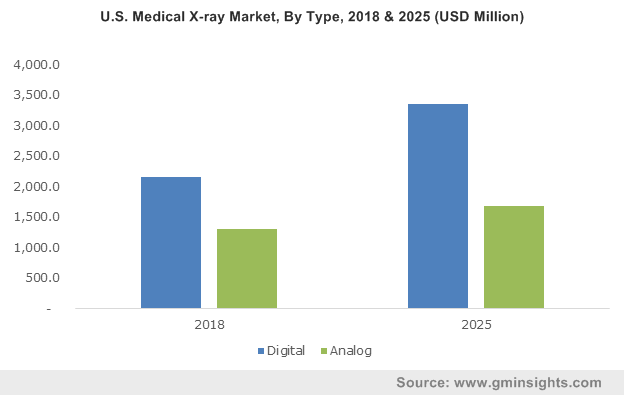Medical X-ray market to amass remarkable gains from hospitals by 2025, global industry to be characterized by a stringent regulatory landscape
Publisher : Fractovia | Published Date : 2019-06-11Request Sample
The competitive hierarchy of medical X-ray market is all inclusive of renowned giants investing heavily in novel product developments and innovations in a bid to enhance the precision of medical imaging. For instance, a leading Japan based medical equipment manufacturer, has recently unveiled its latest edition of MobileDaRt Evolution system in the medical x-ray industry. An enhanced state-of-the-art version of its predecessor, Shimadzu’s MX8 digital mobile X-ray system, reportedly, features the company’s first telescoping support column that ensures an enhanced forward visibility and convenient drivability.
U.S. Medical X-ray Market, By Type, 2018 & 2025 (USD Million)

Add to it, the redesigned model proudly encompasses lockable Flat Panel Detector (FPD), a completely flat monitor screen, a diversified range of operational options, which collectively ensures an astounding operability. Needless to mention, experts have been already raving about this ground-breaking technology, claiming it to prove to be disruptive for the entire medical X-ray industry.
The cosmos of medical imaging has witnessed a heavy impact of technological advancements over the past few years - X-rays being the one of its fundamental verticals, the influence has been colossal. In this regard, direct digital radiography, tentatively called as DR technology, which was a fantasy even a few years back, has been now gaining a mass prominence in medical X-ray market across varied healthcare domains such as cardiovascular, mammography, orthopedic, and the likes.
The paradigm shift from conventional, non-portable x-ray devices to portable, user friendly, mobile digital x-ray systems, quite effectively justifies the exponential growth curve of the DR- based medical X-ray market. These systems are primarily deployed in hospitals for continuous monitoring of patients in neonatal intensive care units, or in emergency rooms. Speaking of hospitals, it comes as no surprise that they are one of the largest revenue grounds for medical X-ray industry. With a profound surge in the number of patients relying on hospital settings for the best diagnoses and treatment, as well as the commendable incline in the number of surgical procedures globally, medical X-ray market share from hospitals is projected to expedite majorly in the years to come.
Another pivotal factor responsible for the uptick in medical X-ray industry size from hospitals is the availability of highly sophisticated healthcare infrastructure worldwide. As per estimates, medical X-ray market share from hospitals is anticipated to depict a CAGR of 6.4% over 2019-2025.
Another important factor which has played its card in the industry proliferation is the strict regulatory framework encompassing the safety norms that need to be implemented while manufacturing these X-ray devices. Say for instance, the Radiation Emitting Device Act, initiated by the U.S. Food and Drug Administration, under the sections 531, deals with the import, sale, lease of several radiation emitting devices that are widely employed across medical as well as non-medical domains. Perhaps marred by the fact that medical images produced X-rays, especially CT scans are the most profound sources of medical radiation, these mandatory roll outs have turned out to be of extreme significance for medical X-ray market players to ensure patient’s safety and welfare. As per statistics, X-rays account for more than 89% of the annual radiation exposure.
Faced by the relentless pressure of acute health problems resulting from the prolonged exposure to high radiation, biggies involved in medical X-ray market have been highly banking on research activities to come up with innovative technologies that might dilute the hazardous impact to some extent. Healthcare giants have also identified the need and implemented several measures to considerably lessen the radiation dosage. The rise in the number of such initiatives, as per experts, can bring about a profound transformation in medical X-ray industry dynamics.
Given this grim backdrop, recently, a group of scientists have unveiled a mathematical model, dubbed as linear no-threshold theory, which is capable of setting radiation standards. Using a recognized higher dosage of radiation, which has a catastrophic impact on human health, one can extrapolate linearly to lower dose using the algorithm. In fact, estimates depict that if 1000 units of radiation causes 5% impact, this extrapolation would result in 0.5% impact on 100 units. While the study is still waiting to be implemented on mainstream clinical medicine, the designing of the algorithm has already sent out waves of anticipation in medical X-ray industry. Persistently being channelized by the continuous advancement of technology in tandem with governmental support with regards to medical research and development, medical X-ray industry is forecast to exceed a valuation of USD 16.5 billion by 2025.